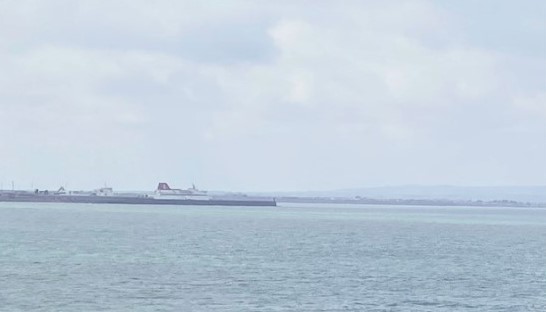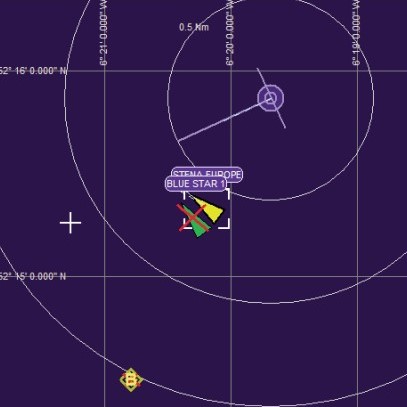The Marine Casualty Investigation Board (MCIB), the Irish government agency for investigating maritime accidents and incidents, published its report of an incident involving two passenger ferries at Rosslare Harbour, Co. Wexford.
The incident
On the morning of 16 March 2022, just outside the breakwater of Rosslare Harbour, Co. Wexford, two large passenger ferries engaged in a close quarter incident resulting in the ferries passing approximately 100 metres (m) apart.
The inbound vessel “Connemara” arrived from Bilbao in Spain; it was scheduled to arrive at 08.15 hours (hrs). This vessel arrived early and was asked by Rosslare Port Control to wait outside the harbour in the vicinity of West Holdens buoy. The outbound vessel “Stena Europe” was scheduled to sail for Fishguard in the United Kingdom (UK) at 07.30 hrs.
“Connemara” did not follow the instructions from Rosslare Harbour Control and instead of holding position proceeded towards the breakwater. “Stena Europe” was given permission to sail by Rosslare Port Control and departed its berth unaware that “Connemara” was approaching the breakwater. The two vessels met each other just off the breakwater. Both vessels had to take action to avoid collision resulting in a close quarter situation.

Analysis
The “Connemara” being the inbound vessel was early. When they were advised that they would have to wait until the outbound vessel “Stena Europe” sailed, they had a number of options.
“Connemara” claimed that because of a strong northerly breeze it had no option but to maintain speed. This may be the case; however, it does not explain why it decided to proceed towards the port instead of proceeding further to the north where there was plenty of sea room to manoeuvre.
Both the Master and relieving Master stated that they attributed their action to mis-understood and mis-heard VHF communications. The relieving Master also stated that he was concerned about tides and being late for their arrival time if the vessel proceeded to the north of West Holdens. Had it arrived at its designated time this incident would have been avoided. The failure to carry out Rosslare Europort’s VTS advice to wait at West Holdens is a causative factor of this incident.
The helmsperson of “Connemara” was ordered to steer 245° after the “Connemara” passed West Holdens buoy, this is a course directly for the entrance to the harbour. The inbound vessel was informed by VTS, over the VHF radio that the “Stena Europe” would be sailing soon.
This was acknowledged by “Connemara”. A report can be clearly heard on the VDR audio recording of one of the bridge team stating “she is moving” as soon as “Stena Europe” started moving. The inbound vessel should have been aware at this stage that a close quarter situation could develop at the entrance to the harbour unless action was taken.
The bridge team onboard “Connemara” made the decision to proceed towards the breakwater. No effort was made to hold “Connemara” at West Holdens buoy as advised by VTS. The Master of “Connemara” stated that he was unable to remember or identify from the VDR recording who made the comment of “she is moving”. Poor bridge team management and inappropriate VHF procedures were a contributing factor in this close quarter incident.
The relieving Master was giving the helm orders on the “Connemara”. He ordered the helm to starboard 20° and reduce speed immediately prior to a member of the bridge team calling “Stena Europe” on VHF to ask if it were going to turn or cross their bow.
The bridge team were unable to recall who made the VHF call. The MCIB has been unable to get an explanation from either the Master or the relieving Master onboard “Connemara” as to the reason for this action or why more substantial action was not taken much earlier.
It is clear from the SMS that the Master retained command at all times despite the fact that the relieving Master was giving helm and engine orders. The relieving master was effectively bringing the vessel into Rosslare as a training exercise under the supervision of the Master. Poor communication between the Master and the relieving Master contributed to the close quarter situation developing.
Statements received from the bridge team of “Connemara” conflict with analysis of the VDR recording with respect to manoeuvring, position, speed and communications. On review of the VDR recording, the off-signing Master of “Connemara” concluded that there were a number of facts that he did not remember until he reviewed the VDR recording.
On reviewing the VDR recording he stated that he could not be sure which member of the bridge team was operating the VHF or if the messages were relayed. As a result of the language used in the VHF conversations, Rosslare Harbour Control was led to believe that the “Connemara” was going to hold at West Holdens. Inappropriate VHF procedures and language contributed to this incident.
The outbound and inbound vessels should have been able to monitor each other both visually and by means of radar and Automatic Identification System (AIS). The Harbour Master of Rosslare Port has confirmed that in his opinion both vessels would have had a clear visual, radar and AIS view of each other.

Conclusions
The bridge team of “Connemara” failed to follow instructions from Rosslare Port Control and instead proceeded directly towards the port knowing that another vessel was outbound.
Although it was the stand on vessel under the IRPCS and therefore obliged to maintain course and speed in a crossing situation where risk of collision existed, under IRPCS; Rule 17 (a) (ii) the option was available to “Connemara” at any time to alter course and/or speed.
Rule 17 (a) (ii) states that as soon as it becomes apparent that the give way vessel, in this case the outbound vessel “Stena Europe”, was not taking appropriate action, the stand on vessel may take action.
In his statement, the Master of the inbound vessel “Connemara” said he was unclear of the intentions of outbound vessel. This uncertainty is also evident from the VHF conversation at 07.28 hrs where the inbound vessel asks the outbound vessel if it is going to alter to starboard or cross ahead.
Given this uncertainty, the inbound vessel, “Connemara”, should have taken greater action, and taken it much earlier, in order to avoid this close quarter situation. Further to this, under the IRPCS; Rule 2 (b), the inbound vessel could have at any time, altered course and/or speed as necessary as the rule specifically allows for a departure from the rules to “avoid immediate danger”.
The inbound vessel could have avoided the situation entirely by utilising the deep water to the north of West Holdens buoy to manoeuvre while waiting for the outbound vessel to clear the channel, therefore, avoiding any possibility of a close quarter situation developing.
This is also something that could have been communicated to the inbound vessel by Rosslare Port Control had the duty Port Controller noticed that the inbound vessel was not following his advices.
It is evident from the VDR recording and conflicting statements received from the bridge team of “Connemara” that communication among the bridge team was extremely poor leading to a situation where there was uncertainty as to who was in control of the situation.
It is further evident from the “Connemara” VDR recording and statements from the bridge team that planning, in particular contingency planning, among the bridge team was severely lacking.
The outbound vessel was in a position to have avoided this close quarter situation. It is evident from its VDR recording that it was concerned about its sailing time and not being held up by the early arrival of “Connemara”.
This may have affected its decision making process and caused it to overlook the progress of the inbound vessel in its eagerness to sail on schedule. The final decision to depart the berth is up to the Master of the vessel.
This is reflected in the SMS which states that the Master must ensure all statutory requirements are complied with. This includes the IRPCS which requires keeping a lookout at all times. The bridge team on “Stena Europe” did not comply with this.

































































